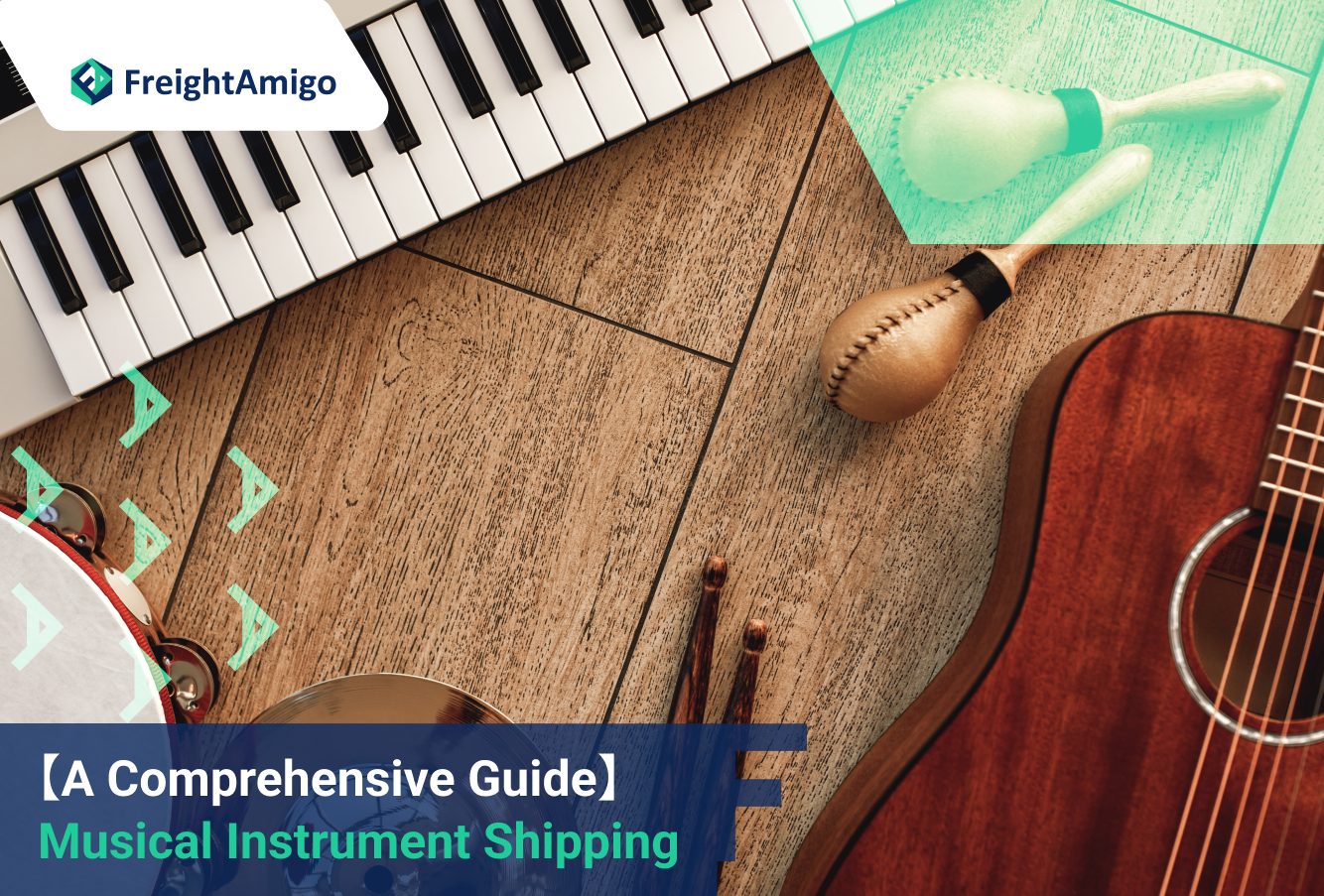Latest update on 29 February, 2024 by Maya Wong – Marketing Analyst at FreightAmigo
Shipping musical instruments can be a complicated process. Whether it is a beloved guitar, a cherished violin, or a grand piano, each instrument requires special attention to ensure it arrives at its destination in perfect condition. This guide provides an in-depth look at the considerations and precautions involved in musical instrument shipping.
Want to compare the best Express, Air Freight, Sea Freight, Rail Freight & Trucking rates so as to have better control on cost?
The Complexities of Musical Instrument Shipping
Shipping musical instruments is a specialized field that necessitates a careful approach. Each instrument, from a delicate violin to a bulky piano, presents unique challenges due to its size, shape, and material composition. These complexities require an understanding of the instrument’s characteristics, the transportation environment, and the potential risks associated with shipping.
Size and Weight
The size and weight of a musical instrument can significantly impact the shipping process. Larger instruments, such as pianos or drum sets, may require specialized packaging or even a customized crate to ensure their safe transport. Conversely, smaller instruments like violins or flutes may be easier to package but their delicate nature still necessitates careful handling.
Fragility and Value
Musical instruments are often highly valuable, both in terms of monetary cost and sentimental value. This makes the stakes of shipping them safely even higher. Additionally, many instruments are extremely fragile. Stringed instruments, for example, can be easily damaged by changes in temperature and humidity, while percussion instruments can be susceptible to impact damage.
Choosing the Right Shipping Method
Choosing the right shipping method is crucial when transporting musical instruments. Factors such as the destination, timeline, and instrument’s specific requirements all play a role in determining the best method.
Destination
The destination of the shipment can significantly influence the choice of shipping method. International shipping may involve customs regulations and additional documentation, while domestic shipping may offer a wider range of carrier options.
Timeline
The urgency of the delivery also plays a role in choosing the shipping method. Expedited shipping options can ensure a faster delivery, but these services often come at a higher cost.
Instrument-Specific Requirements
Each musical instrument has unique shipping requirements. For instance, stringed instruments may need to be shipped with their strings loosened to prevent snapping due to temperature or pressure changes. Similarly, wind instruments should be dismantled and each part wrapped separately for optimal protection.
Packing Musical Instruments for Shipping
Proper packing is vital to ensure the safe shipping of musical instruments. From using the right materials to following instrument-specific packing guidelines, each step in the packing process plays a crucial role in protecting the instrument from potential damage.
Packing Materials
Choosing the right packing materials is the first step in preparing a musical instrument for shipping. Strong, durable boxes or crates are essential to protect the instrument during transit. Internal packing materials such as bubble wrap, foam padding, or packing peanuts can provide additional protection by cushioning the instrument and preventing movement within the box.
Instrument Cases
Whenever possible, musical instruments should be shipped in their specific cases. These cases are often designed to protect the instrument from damage and provide an extra layer of protection during shipping. If an instrument case is not available, the instrument should be securely wrapped in multiple layers of bubble wrap and other cushioning materials.
Packing Process
The packing process for musical instruments requires careful attention to detail. The instrument should be prepared according to its specific requirements, such as loosening the strings of a guitar or dismantling a wind instrument. The instrument or its case should then be wrapped securely in protective materials and placed in a sturdy box or crate. Any voids in the box should be filled with additional padding to prevent movement during transit.
The Role of Climate Control in Musical Instrument Shipping
Climate control plays a pivotal role in the safe shipping of musical instruments. Many instruments are sensitive to changes in temperature and humidity, which can cause warping, cracking, or other damage.
Shipping carriers that offer climate-controlled transportation can help mitigate these risks. These services maintain a consistent temperature and humidity level within the shipping container, providing an optimal environment for sensitive items like musical instruments.
Working with Specialized Carriers
Collaborating with carriers specialized in musical instrument shipping can offer significant advantages. These carriers have the expertise and equipment necessary to handle the unique challenges of shipping musical instruments.
Specialized carriers often provide services such as custom packaging, climate-controlled transport, and comprehensive insurance coverage. They may also offer tracking services, allowing you to monitor the progress of the shipment and ensure that it is being handled properly throughout the journey.
Insurance Considerations
Insuring your musical instrument shipment is a crucial step in the shipping process. Given the high value and delicate nature of many instruments, having comprehensive insurance coverage can provide peace of mind and financial protection in case of damage or loss during transit.
When choosing an insurance policy, it’s important to consider the full value of the instrument, including its monetary cost and potential repair or replacement expenses. It may also be beneficial to work with an insurance provider who specializes in musical instruments, as they will have a better understanding of the specific risks involved.
Conclusion
Shipping musical instruments requires careful planning and attention to detail. From choosing the right shipping method and packing materials to understanding the role of climate control and the importance of insurance, every step in the process is crucial to ensuring the safe arrival of the instrument. With the right knowledge and resources, including the use of specialized shipping services like FreightAmigo, you can successfully navigate the complexities of musical instrument shipping.
For musical instrument shipping, consult logistics experts like FreightAmigo. Visit the FreightAmigo website to inquire about our secure and specialized shipping services for preserving musical instruments.
Read More:
【Logistics 101】 How to Safely Handle Fragile Items During the Shipping Process
【Fragile and High-Value Shipments】 The Importance of Insurance Coverage
【Sending Musical Instruments】 Complete Guide with Tips
If you have any inquiries on logistics/supply chain, feel free to contact FreightAmigo now:
Chat with us online | Hotline: +852 28121686 | WhatsApp: +852 27467829









































